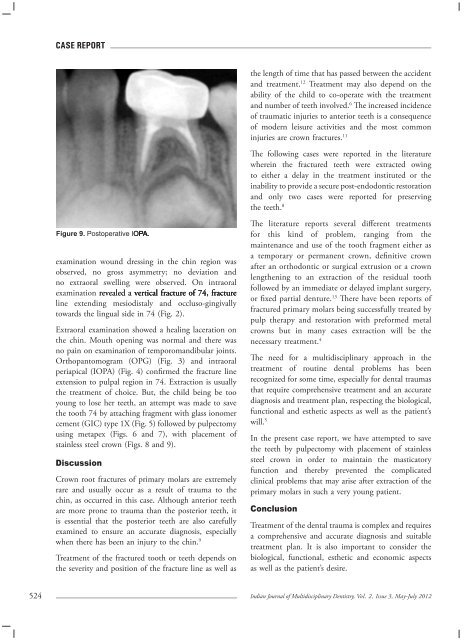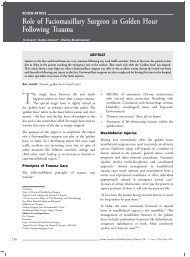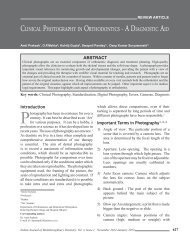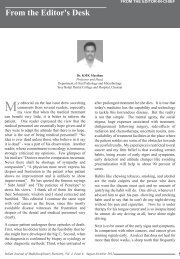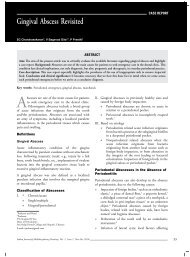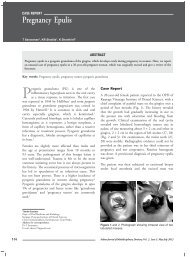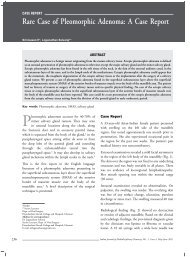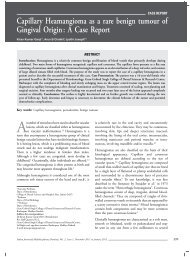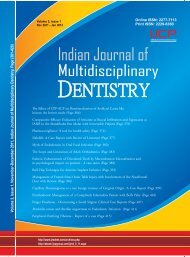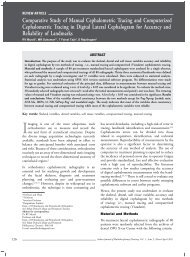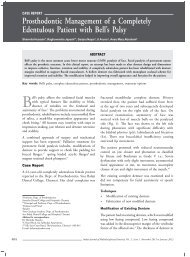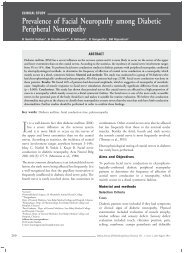Volume 2 - Issue 3 (May-Jul)
Volume 2 - Issue 3 (May-Jul)
Volume 2 - Issue 3 (May-Jul)
You also want an ePaper? Increase the reach of your titles
YUMPU automatically turns print PDFs into web optimized ePapers that Google loves.
Case Report<br />
the length of time that has passed between the accident<br />
and treatment. 12 Treatment may also depend on the<br />
ability of the child to co-operate with the treatment<br />
and number of teeth involved. 6 The increased incidence<br />
of traumatic injuries to anterior teeth is a consequence<br />
of modern leisure activities and the most common<br />
injuries are crown fractures. 11<br />
The following cases were reported in the literature<br />
wherein the fractured teeth were extracted owing<br />
to either a delay in the treatment instituted or the<br />
inability to provide a secure post-endodontic restoration<br />
and only two cases were reported for preserving<br />
the teeth. 8<br />
Figure 9. Postoperative IOPA.<br />
examination wound dressing in the chin region was<br />
observed, no gross asymmetry; no deviation and<br />
no extraoral swelling were observed. On intraoral<br />
examination revealed a vertical fracture of 74, fracture<br />
line extending mesiodistaly and occluso-gingivally<br />
towards the lingual side in 74 (Fig. 2).<br />
Extraoral examination showed a healing laceration on<br />
the chin. Mouth opening was normal and there was<br />
no pain on examination of temporomandibular joints.<br />
Orthopantomogram (OPG) (Fig. 3) and intraoral<br />
periapical (IOPA) (Fig. 4) confirmed the fracture line<br />
extension to pulpal region in 74. Extraction is usually<br />
the treatment of choice. But, the child being be too<br />
young to lose her teeth, an attempt was made to save<br />
the tooth 74 by attaching fragment with glass ionomer<br />
cement (GIC) type 1X (Fig. 5) followed by pulpectomy<br />
using metapex (Figs. 6 and 7), with placement of<br />
stainless steel crown (Figs. 8 and 9).<br />
Discussion<br />
Crown root fractures of primary molars are extremely<br />
rare and usually occur as a result of trauma to the<br />
chin, as occurred in this case. Although anterior teeth<br />
are more prone to trauma than the posterior teeth, it<br />
is essential that the posterior teeth are also carefully<br />
examined to ensure an accurate diagnosis, especially<br />
when there has been an injury to the chin. 9<br />
Treatment of the fractured tooth or teeth depends on<br />
the severity and position of the fracture line as well as<br />
The literature reports several different treatments<br />
for this kind of problem, ranging from the<br />
maintenance and use of the tooth fragment either as<br />
a temporary or permanent crown, definitive crown<br />
after an orthodontic or surgical extrusion or a crown<br />
lengthening to an extraction of the residual tooth<br />
followed by an immediate or delayed implant surgery,<br />
or fixed partial denture. 13 There have been reports of<br />
fractured primary molars being successfully treated by<br />
pulp therapy and restoration with preformed metal<br />
crowns but in many cases extraction will be the<br />
necessary treatment. 4<br />
The need for a multidisciplinary approach in the<br />
treatment of routine dental problems has been<br />
recognized for some time, especially for dental traumas<br />
that require comprehensive treatment and an accurate<br />
diagnosis and treatment plan, respecting the biological,<br />
functional and esthetic aspects as well as the patient’s<br />
will. 5<br />
In the present case report, we have attempted to save<br />
the teeth by pulpectomy with placement of stainless<br />
steel crown in order to maintain the masticatory<br />
function and thereby prevented the complicated<br />
clinical problems that may arise after extraction of the<br />
primary molars in such a very young patient.<br />
Conclusion<br />
Treatment of the dental trauma is complex and requires<br />
a comprehensive and accurate diagnosis and suitable<br />
treatment plan. It is also important to consider the<br />
biological, functional, esthetic and economic aspects<br />
as well as the patient’s desire.<br />
524<br />
Indian Journal of Multidisciplinary Dentistry, Vol. 2, <strong>Issue</strong> 3, <strong>May</strong>-<strong>Jul</strong>y 2012


